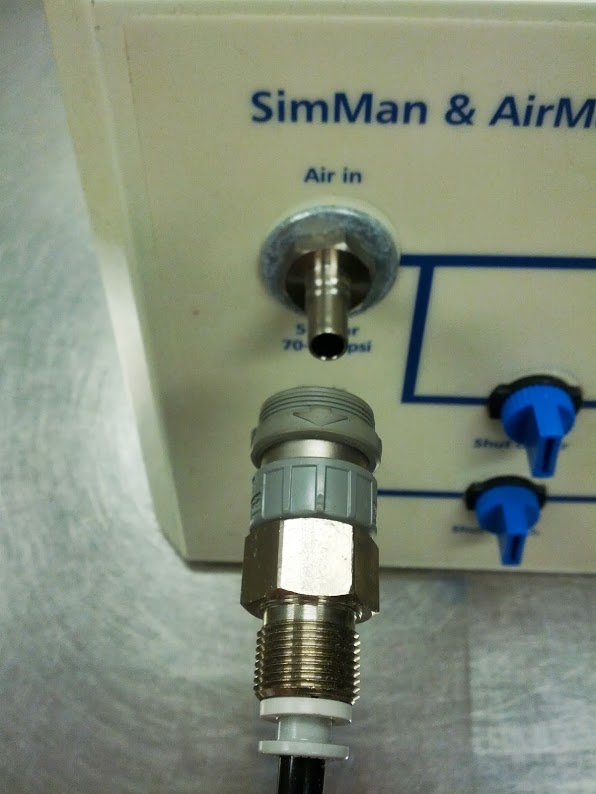About SimMan From Laerdal
SimMan is one of the most well-known patient simulators in healthcare simulation. Learning about the SimMan, manufactured by Norwegian-based Laerdal Medical, can help Healthcare Simulation professionals stay current and up to date on best practices. This unique Manikin, also known as a patient simulator, is specifically designed to provide healthcare students and professionals with the opportunity to educate and train in high-fidelity Medical Simulation environments. Here’s what healthcare professionals who focus on education and training need to know about the different types of SimMan available from Laerdal, including the latest updates on this popular Patient Simulator.
The Importance of Manikins in Clinical Simulation Settings
The SimMan from Laerdal is a type of Human Patient Simulator known as a high-fidelity Manikin, which are used in Clinical Simulation to most closely mimic clinical patient encounters. A “high-fidelity” manikin means it has “high-realism”, and usually is received for the highest tiers of medical simulator with the most realistic patient presentation features, such as real-time pupil dilation, RFID-tag drug recognition, wireless operation, and internal a/v components like speakers and even eye cameras. Healthcare learners can develop and hone their skills using a life-like Patient Simulator before applying their knowledge on an actual patient, benefitting both the learner and their future patients. The SimMan enables healthcare institutions to provide learners with the opportunity to engage in interprofessional education scenarios, such as mock codes, giving learners the chance to practice working within a multidisciplinary team to coordinate patient care.
Sponsored Content:
HealthySimulation.com is dedicated to providing the latest SimMan resources from around the world. To follow along, sign up for our medical simulation email newsletter, follow @HealthySim on Twitter and @HealthySim on Facebook, or join our HealthySimulation.com Linkedin Company Page
The SimMan from Laerdal further enriches the educational experience through its log file export function. By exporting log files, educators can review a simulated patient’s exact vital signs, connecting learner action and ongoing trends for the purpose of team debriefing, research, or both. This can be a high-yield way of assessing a learner’s performance in real-time and delivering feedback and constructive criticism in a setting that allows unlimited opportunities for augmenting skills.
The History of the SimMan Patient Simulator
The first version of SimMan (now called the SimMan classic) was released in 2001. It was developed in partnership with Dr. Rene Gonzales and Dr. John Schaefer via the University of Pittsburgh and Medical Plastics Corporation (MPL). The Norwegian-based Laerdal acquired MPL to develop the Manikin further. The first version of this SimMan Patient Simulator brought enhanced realism into the Clinical Simulation setting by using an external air compressor capable of demonstrating real-time palpitations.
When it was developed, the SimMan training system was significantly more affordable than its competitor’s predecessors (such as CAE Healthcare’s HPS or iStan). This affordability helped fuel the adoption of Patient Simulator technology beyond top medical schools and into Nursing Simulation educational settings as well as allied health programs.
Sponsored Content:
SimMan3G – The Workhorse!
The original SimMan (the SimMan Classic) was discontinued in 2011 and is no longer supported. The current primary version of Laerdal’s high-fidelity simulator is the SimMan 3G, first launched in 2009. This version improves upon the SimMan Classic by introducing a more powerful battery life, wireless control, an internal air compressor, new software GUI system, fluid ports, RFID tagged medication use, CPR feedback, improved patient skins, blinking and dilating pupils, and more. The SimMan3G has seen a vast number of incremental hardware improvements since 2009 and it is among the top-selling Patient Simulators in the world.
Click Here to Connect to Leading Moulage Training and Product Vendors!Another advancement in Patient Simulator technology is the SimMan 3G Plus from Laerdal, which helps augment any medical or Nursing Simulation environment through intense realism, such as interchangeable headskins, fully articulating arms, non-invasive blood pressure measurement, improved pulses, pulse oximetry monitoring, and the ability to administer intraosseous or intramuscular medications using real devices and fluids. The realistic aspects of the SimMan 3G Plus enable a level of immersion that can help students become fully engaged in any clinical scenario and experience the range of emotions and challenges they will experience in the field during actual patient encounters. This can help them mentally prepare for what they will face and at the same time, have a safe, risk-free setting to practice as much as they need to feel confident.
SimMan Critical Care
Laerdal Medical has partnered with IngMar Medical to provide critical care and respiratory training, which includes basic to advanced ventilation management, in a single high-fidelity patient simulator: SimMan Critical Care. To deliver optimal patient care for life-threatening critical and respiratory conditions, healthcare providers need comprehensive and effective training. Simulation can help current and future clinicians be prepared to care for critically ill patients by providing realistic training opportunities that allow learners to master essential skills and build confidence through deliberate, repetitive practice – without any risk to real patients.
dw-classnames: embed-responsive,embed-responsive-16by9
“We know that critical and respiratory care are complex areas of practice – and that simulation training, especially when conducted realistically in the actual clinical environment, can provide crucial hands-on learning opportunities to help clinicians master these skills and build preparedness using their own equipment,” says Neil Weber, President, Laerdal North America. “We’re excited to release SimMan Critical Care, which facilitates these ‘in situ’ simulations and delivers a training experience that will ultimately empower current and future healthcare providers with the skills and confidence they need to deliver the highest-quality care to every critically ill patient.”
Other Patient Simulator Options From Laerdal
In addition to the SimMan 3G, there is a more affordable version of the Manikin with fewer features called the SimMan Essential. Another version, which is dedicated to Ventilation, is dubbed the SimMan ALS. This is designed to be highly mobile and durable, and it can help with the training of healthcare providers in the pre-hospital setting. Yet another version of the SimMan is designed for Vascular surgeries and it is dubbed the SimMan Vascular. According to its manufacturer, this Patient Simulator is the “first medical simulator designed to cover the entire patient pathway in the treatment of stroke, heart attack, and acute trauma cases.” The versatility of this simulator allows for realistic cath-lab procedures, in which clinicians can use the actual tools they will be using every day. It also allows for learners to practice catheter placement and stenting, and it even allows for low-dose fluoroscopy, enabling vascular teams to have real-time feedback, just as they would in a real clinical setting. Similarly, a SimMan 3G Trauma has been created to address the educational needs of healthcare professionals in another niche setting—the military.
Special Features of the SimMan Patient Simulator
The SimMan has several features that enhance its value for learners. Using a microphone in a Simulation lab control room, Simulation facilitators can speak as the Patient’s voice through a speaker in SimMan’s head. This can help enhance the realism and momentum of a clinical scenario, and it can also help guide the narrative of any clinical scenario. Ultrasound is also possible on the SimMan with additional skins. While SimMan’s limbs can be positioned somewhat, at this time the simulator does not automatically move its limbs or facial features on its own. However, the simulator’s chest will rise and fall with appropriately-sized breaths, its eyes can blink and dilate, and it can also secrete liquids like tears, cranium fluid, urine, or blood from a wound.
Using Patient Simulators in Clinical Scenarios
The SimMan Manikin can be pre-programmed to run a specific patient case, or it can also be operated “on the fly,” in an ad-lib fashion. Both of these functions can be controlled and managed by a Healthcare Simulation Technology Specialist. Most commonly, pre-programmed scenarios are used that enable the educator to change the direction of a patient’s status based on a learner’s actions. The educator can take over and run any mock scenario manually as well, should the need arise.
How Patient Simulators Have Addressed Clinical Education Needs During COVID-19
SimMan Patient Simulators’s lineage has played a central role in educating healthcare professionals since its creation in 2001. However, the onset of the COVID-19 pandemic has crystallized the utter importance of Medical Simulation for learners, particularly as hospitals and training programs had to pause rotations and internships to preserve supplies and reduce viral exposures. In the meantime, learners benefited greatly from the ability to continue learning critical skills using high-fidelity Patient Simulators. The SimMan’s unique features allowed learning to continue, even though in-person learning in the hospital setting was put on hold.
Simulation training provided a critical avenue for clinicians who were already in professional practice and who needed to adapt quickly to a new pandemic environment and even learn new clinical skills. According to the SimMan manufacturer, Laerdal, Patient Simulators helped healthcare providers unfamiliar with respiratory care gain clinical competence and confidence to best serve the influx of patients falling ill with COVID-19. Scholars have noted that Medical Simulation played a crucial role in responding to the pandemic, especially in New York City, where the very first group of patients fell ill, and healthcare teams faced the challenge of responding rapidly and appropriately.
Ultrasound is also possible on the SimMan with additional skins from SonoSim.
Using SimMan Technology as a Path Forward for Better Outcomes
In any healthcare setting, it is evident that Patient Simulators can provide added value for learners and enhance their ability to adopt new skills or refresh pre-existing knowledge. The five Patient Simulators currently offered by Laerdal—the SimMan 3G, SimMan 3G Plus, SimMan ALS, SimMan Vascular, and SimMan 3G Trauma—are all valuable tools that can bolster any clinical education program.
Reference:
- The role of manikins in nursing students’ learning: A systematic review and thematic metasynthesis. https://www.sciencedirect.com/science/article/pii/S0260691720315112.
- Implementation of Simulation Training During the COVID-19 Pandemic. https://www.ncbi.nlm.nih.gov/pmc/articles/PMC7853723/
SimMan 3G Latest News

Laerdal Introduces SimMan Critical Care

Use of Diverse Facial Overlays for Simulation-Based Medical Training

Laerdal’s SimMan 3G PLUS Upgrades Patient Simulator Features

IngMar Medical Now Connects Respiratory Simulator to SimMan 3G – Exclusive Video Interview

Reader Submitted Video Intro Orientations to Laerdal Simman Classic, Essential, and 3G
Sponsored Content:

















